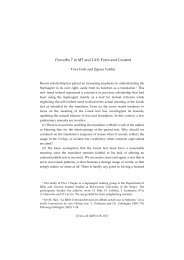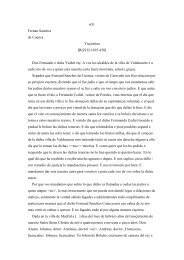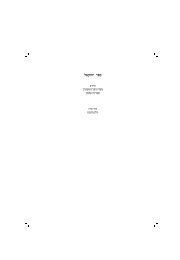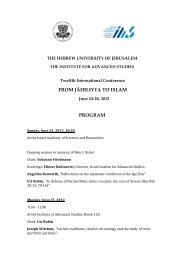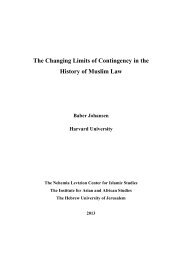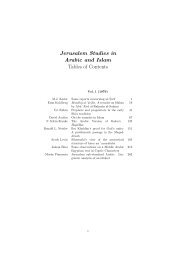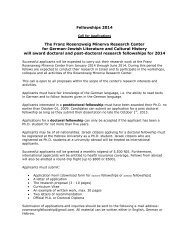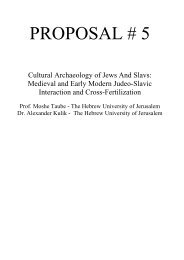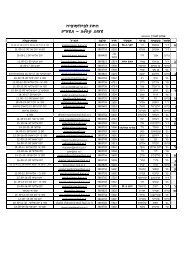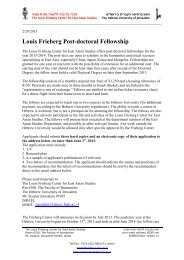THE BOOK OF EZEKIEL Moshe H. Goshen-Gottstein Shemaryahu ...
THE BOOK OF EZEKIEL Moshe H. Goshen-Gottstein Shemaryahu ...
THE BOOK OF EZEKIEL Moshe H. Goshen-Gottstein Shemaryahu ...
Create successful ePaper yourself
Turn your PDF publications into a flip-book with our unique Google optimized e-Paper software.
Introduction<br />
abbrev variant assumed to have resulted from an abbreviation 62<br />
add added; additional 63<br />
app<br />
cross-reference to an entry in another apparatus<br />
apt<br />
contrary to appearance, the rendering is suitable<br />
aram<br />
exegesis based on Aramaic (usually with ‘etym’)<br />
atten<br />
attenuation in the choice of a word; use of a ‘weaker’, viz., less<br />
specific word<br />
condens a longer expression in x reduced to an equivalent shorter translational<br />
phrase, especially in cases of repetition or parallelism<br />
connect a difference relating to the connection between clauses or sentences<br />
ditt dittography 64<br />
dupl textual doublet 65<br />
ed(d)<br />
printed edition(s)<br />
etym<br />
interpretation based on a particular etymology<br />
evid<br />
‘main evid’(ence), when the printed text of the edition is based on<br />
a minority reading<br />
ex variance due to direct influence or borrowing from another text 66<br />
exeg<br />
exegetical change, sometimes specified as due to geography, theology,<br />
etc.; combined with ‘synt’ indicates different syntactic exegesis<br />
67<br />
expans expanded rendering (sometimes creating new parallel)<br />
formula variant concerning a fixed expression or phrase recurring in different<br />
forms 68<br />
gloss<br />
explanatory gloss entered by editor, scribe or translator, which<br />
sometimes leads to ‘dupl’ 69<br />
62 Cf. G. R. Driver, “Abbreviations in the Massoretic Text,” Textus 1 (1960) 112–131; idem, “Once<br />
Again Abbreviations,” Textus 4 (1964) 76–94; M. Fishbane, “Abbreviations, Hebrew Texts,”<br />
IDBSup, 3–4. Cf. also Tov, TCHB, 256–257.<br />
63 Including exegetical additions from a similar text or texts. An excessively long addition is indicated<br />
by ‘add’ in the apparatus, with the added text given in the notes (cf. e.g., 24:14).<br />
64 Cf. ‘hapl’.<br />
65 Also indicates double translations, e.g., 1:4, n. 2. Cf. S. Talmon, “Double Readings in the Massoretic<br />
Text,” Textus 1 (1960) 144–184; idem, “Conflate Readings (OT)”, IDBSup, 170–173; idem, in<br />
Talmon-Cross, 321–400. Cf. also Tov, TCHB, 241–243.<br />
66 In contrast with the general reference ‘cf’.<br />
67 In Ezek 40–48, several apparent differences were qualified as ‘architectural exegesis’ (cf., e.g.,<br />
40:12, 13; 42:3).<br />
68 Cf., e.g., 2:7, n. 1; 25:15, n. 2.<br />
69 Cf. E. Tov, “Glosses, Interpolations, and Other types of Scribal Additions in the Text of the Hebrew<br />
Bible,” Language, Theology, and the Bible: Essays in Honour of James Barr (ed. S. E. Balentine and<br />
J. Barton; Oxford: Clarendon Press, 1994) 40–66 [=Greek & Hebrew Bible, 53–74].<br />
xxvi



